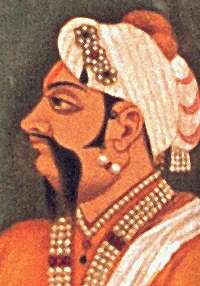Jodhpur State
| Jodhpur State जोधपुर रियासत/मारवाड़ राज्य | ||||||
| Princely State of British India | ||||||
| ||||||
| ||||||
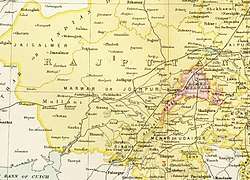 | ||||||
| History | ||||||
| • | Established | 1226 | ||||
| • | Independence of India | 1949 | ||||
| Area | ||||||
| • | 1931 | 93,424 km2 (36,071 sq mi) | ||||
| Population | ||||||
| • | 1931 | 2,125,000 | ||||
| Density | 22.7 /km2 (58.9 /sq mi) | |||||
| Today part of | Rajasthan, India | |||||
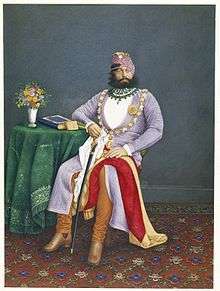
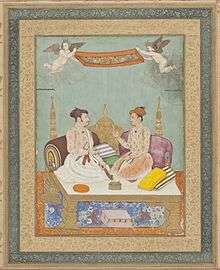


Jodhpur State also historically known as the Kingdom of Marwar (Hindi:मारवाड़ राज्य), was a princely state in the Marwar region from 1226 to 1949. Its capital was the city of Jodhpur since 1450.
Covering an area of 93,424 km², Jodhpur State was the largest state under the Rajputana Agency. Its last ruler signed the accession to join the Indian Union on 7 April 1949 and the state was formally dissolved on 1 November 1956.[1]
History
The Rathore rulers of the Indian princely state of Jodhpur were of an ancient dynasty established in the 8th century. However, the dynasty's fortunes were made by Rao Jodha, first of the rulers of the Rathore dynasty in Jodhpur in 1459. Out of the 15 rulers that preceded Jodha, 9 died on the battlefield, of them six against foreign armies. Jodhas son himself died after a battle in which he saved 140 women from Afghan raiders.[2]
The kingdom was annexed by the Mughal Empire in 1583 after the death of Chandrasen Rathore. It remained under direct Mughal control until Udai Singh was restored to the throne as a vassal and given the title of Raja. During the late 17th century it was under the strict control of the Mughal Emperor Aurangzeb, but the ruling house of Rathore was allowed to remain semi-autonomous in their territory. During this time Durgadas Rathore struggled to preserve the rathore dynasty and freed Marwar from the Mughal Empire after 25 years of war. The British had no role in the state's affairs until the 1830s, when the Raja at that time, Man Singh, entered into a subsidiary alliance, after which the Rajas of Marwar (or Jodhpur) continued as rulers of a princely state.
Following Indian independence in 1947 Maharaja Hanwant Singh, the last ruler of Jodhpur state, delayed signing the Instrument of Accession to India. He even briefly considered acceding to Pakistan, for Jodhpur shared a border with the new nation and he had been personally given assurance of access to sea ports in Pakistan by Muhammad Ali Jinnah. Finally, he agreed to the accession of his state to the new Dominion of India, but not before a last-minute dramatic scene.[3][4]
Rulers of Marwar
Rulers 1226–1438 (From Pali & Mandore)
| Name | Notes | Reign began | Reign ended | |
|---|---|---|---|---|
| 1 | Rao Sheoji | Grandson of Raja Jaichand of Kannauj. He conquered Pali and became the first rao of the Rathore dynasty in Marwar. | 1226 | 1273 |
| 2 | Rao Asthan | Conquered Kher from the Gohils. He died in battle against Jalaludin Khilji. | 1273 | 1292 |
| 3 | Rao Doohad | He conquered more than 140 villages. He was killed in battle against the Parihars. | 1292 | 1309 |
| 4 | Rao Raipal | He avenged his father by killing the ruler of the Parihars. During a famine in Marwar he distributed his own personal grains to the people. | 1309 | 1313 |
| 5 | Rao Kanhapal | He suffered raids from the Turko-Afgan tribes and was killed in action defending his lands. | 1313 | 1323 |
| 6 | Rao Jalansi | He defeated the Sodhas. He took the turban of the Sodha chief to mark his supremacy in the region. | 1323 | 1328 |
| 7 | Rao Chado | 1328 | 1344 | |
| 8 | Rao Tida | He was killed in battle against the sultan of Delhi. | 1344 | 1357 |
| 9 | Rao Kanha Dev | 1357 | 1374 | |
| 10 | Rao Viram Dev | He died in battle against the Johiyas. | 1374 | 1383 |
| 11 | Rao Chandra | He conquered Mandore from the Turks in 1406. He was killed in battle against Salim Shah of Multhan. | 1383 | 1424 |
| 12 | Rao Kanha | Fought battles with his brothers. Died young in Mandore. | 1424 | 1427 |
| 13 | Rao Ranmal | He consolidated his rule with the help of the Sisodiyas of Mewar. He was later assassinated on the orders of Rana Kumbha. | 1427 | 1438 |
Rulers 1459–1947 (From Jodhpur)
| Name | Notes | Reign began | Reign ended | |
|---|---|---|---|---|
| 1 | Rao Jodha | Fought Rana Kumbha and reclaimed his lands. He later founded the city of Jodhpur and made it his capital. | 12 May 1438 | 6 April 1489 |
| 2 | Rao Satal | Died from wounds after saving 140 women from Afghan raiders. | 6 April 1489 | March 1492 |
| 3 | Rao Suja | March 1492 | 2 October 1515 | |
| 4 | Rao Biram Singh | Son of Bagha | 2 October 1515 | 8 November 1515 |
| 5 | Rao Ganga | Assisted Rana Sanga in his campaigns against the Sultans of India. | 8 November 1515 | 9 May 1532 |
| 6 | Rao Maldeo | Successfully repelled the invasions of Sher Shah Suri. Called as one of the most potent rulers of Hindustan by Ferishta. | 9 May 1532 | 7 November 1562 |
| 7 | Rao Chandra Sen | Lost his territories in wars with the Mughals | 7 November 1562 | 1581 |
| 8 | Raja Udai Singh Mota Raja | Restored by the Mughals with the title Raja as a vassal | 4 August 1583 | 11 July 1595 |
| 9 | Sawai Raja Suraj-Mal | 11 July 1595 | 7 September 1619 | |
| 10 | Maharaja Gaj Singh I | The first to take the title Maharaja by himself | 7 September 1619 | 6 May 1638 |
| 11 | Maharaja Jaswant Singh | He fought Aurangzeb in the Battle of Dharmatpur. | 6 May 1638 | 28 November 1678? |
| 12 | Raja Rai Singh | Son of Raja Amar Singh | 1659 | 1659 |
| 13 | Maharaja Ajit Singh | Became Maharaja of Marwar after 25 years of war with Aurangzeb. Durgadas Rathore played a key role in the war. | 19 February 1679 | 24 June 1724 |
| 14 | Raja Indra Singh | Installed in opposition to Maharaja Ajit Singh by Emperor Aurangzeb but unpopluar with people of Marwar | 9 June 1679 | 4 August 1679 |
| 15 | Maharaja Abhai Singh | Defeated Sarbuland Khan and occupied all of Gujarat for a short time. | 24 June 1724 | 18 June 1749 |
| 16 | Maharaja Ram Singh | First reign | 18 June 1749 | July 1751 |
| 17 | Maharaja Bakht Singh | He was the general of the Marwari forces against Sarbuland Khan and defeated him. In the Battle of Gangwana he defeated a combined army of Mughals and Kachwahas. | July 1751 | 21 September 1752 |
| 18 | Maharaja Vijay Singh | First reign | 21 September 1752 | 31 January 1753 |
| 19 | Maharaja Ram Singh | Second reign | 31 January 1753 | September 1772 |
| 20 | Maharaja Vijay Singh | Second reign - Was defeated by Mahadji Scindia and forced to surrender the fort and city of Ajmer. | September 1772 | 17 July 1793 |
| 21 | Maharaja Bhim Singh | 17 July 1793 | 19 October 1803 | |
| 22 | Maharaja Man Singh | Entered into treaty relations with the British on 6 January 1818. | 19 October 1803 | 4 September 1843 |
| 23 | Maharaja Sir Takht Singh | Not in the direct line, but a great-great-great grandson of Ajit Singh. Formerly Regent of Ahmednagar. | 4 September 1843 | 13 February 1873 |
| 24 | Maharaja Sir Jaswant Singh II | Kaisar-i-Hind | 13 February 1873 | 11 October 1895 |
| 25 | Maharaja Sir Sardar Singh | Colonel in the British Indian Army | 11 October 1895 | 20 March 1911 |
| 26 | Maharaja Sir Sumair Singh | Colonel in the British Indian Army | 20 March 1911 | 3 October 1918 |
| 27 | Maharaja Sir Umaid Singh | Lieutenant-General in the British Indian Army | 3 October 1918 | 9 June 1947 |
| 28 | Maharaja Sir Hanwant Singh | Ruler of Marwar (Jodhpur) until accession to the Union of India in 1947; died on 26 January 1952 | 9 June 1947 | 15 August 1947 |
| 29 | (titular) Maharaja Gaj Singh II of Jodhpur | Became head of the House on 26 January 1952 | ||
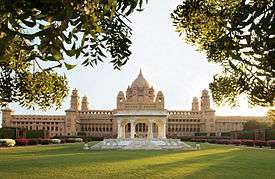
See also
References
- ↑ William Barton, The princes of India. Delhi 1983
- ↑ Vyas, Varsha S. (2007). Rajasthan, the Quest for Sustainable Development. New Delhi: Academic Foundation. p. 355.
- ↑ How did Maharaja of Jodhpur get convinced to be part of Independent India instead of Pakistan?
- ↑ Ramachandra Guha, India after Gandhi: The History of the World's Largest Democracy. HarperCollins, 2007
- Jodhpur, Published by [s.l.], 1933.
- Maharaja Man Singh of Jodhpur and His Times (1803–1843 A.D.), by Padmaja Sharma. Published by Shiva Lal Agarwala, 1972.
- The Administration of Jodhpur State, 1800–1947 A.D., by Nirmala M. Upadhyaya. International Publishers, 1973.
- Marwar under Jaswant Singh, (1658–1678): Jodhpur hukumat ri bahi, by Satish Chandra, Raghubir Sinh, Ghanshyam Datt Sharma. Published by Meenakshi Prakashan, 1976.
- Jodhpur, Bikaner, Jaisalmer: Desert Kingdoms, by Kishore Singh, Karoki Lewis. Lustre Press Ltd. 1992.
- The House of Marwar: The Story of Jodhpur, by Dhananajaya Singh. Lotus Collection, Roli Books, 1994. ISBN 81-7436-002-6.
- Modern Indian Kingship: Tradition, Legitimacy & Power in Jodhpur, by Marzia Balzani. Published by James Currey Limited, 2003. ISBN 0-85255-931-3.
- Jodhpur and the Later Mughals, AD 1707–1752, by R. S. Sangwan. Published by Pragati Publications, 2006.
External links

- The Maharaja Gaj Singh II Of Marwar-Jodhpur (present maharaja), Official website
- Jodhpur History and Genealogy at RoyalArk


